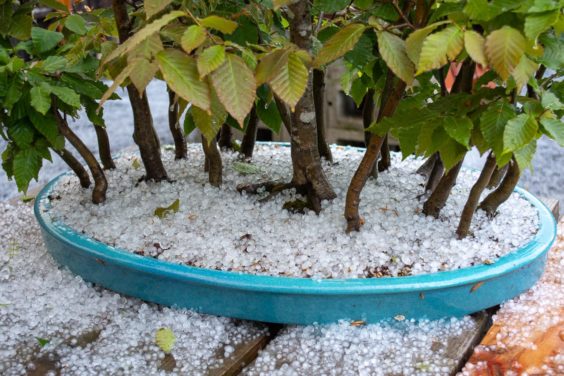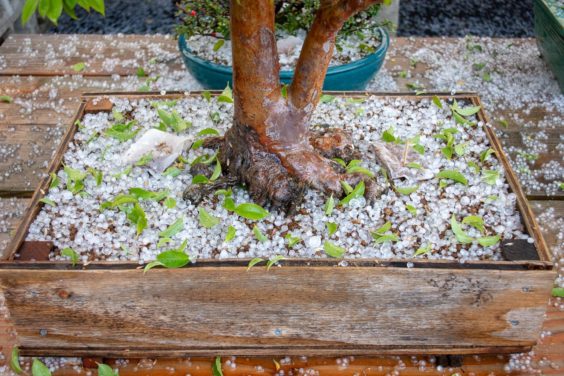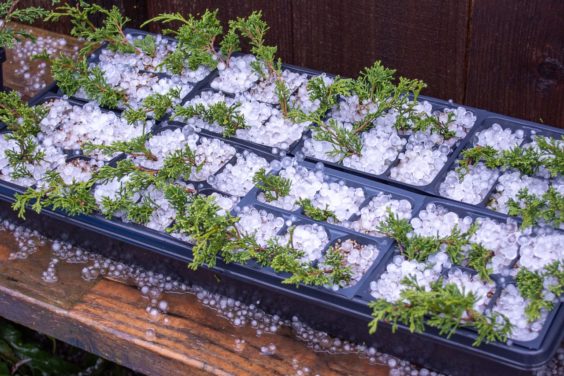Here’s a topic I never planned to address – protecting bonsai from hail damage.
As most readers know far better than I do, hail can quickly damage bonsai – especially deciduous varieties with foliage that has yet to harden off.
Upon realizing that it was hailing yesterday morning, I ran outside and grabbed my smaller deciduous trees to bring them under cover. Fortunately the storm passed quickly, leaving stones that only got up to 1/2″ in size.
Once it cleared up, I took a closer look at my trees and found that most fared well. The pines, for instance, didn’t seem to notice.
Black pines
The Japanese beech also seemed unfazed.
Japanese beech
The stewartia, on the other hand, seemed less happy with the weather as they lost quite a few leaves.
Fallen stewartia leaves
The junipers, whether cuttings or collected specimens, simply shrugged.
Itiogawa shimpaku cuttings
Why didn’t I expect to address the topic? This was the most hail I’d seen in my garden in over 25 years. We typically don’t get much hail, and when it does come, it typically passes quickly.
ABS Gateway to Bonsai in St. Louis this weekend!
Gateway to Bonsai, hosted by the American Bonsai Society and the Bonsai Society of Greater St. Louis, opens this Thursday in Collinsville, Illinois. The event features headliners Marc Noelanders, Bjorn Bjorholm, and Matt Reel, plus workshops, seminars and a large vendor’s area.
I’ll be vending at the event, leading a seminar on advanced wiring, and hosting a workshop that focuses on the creation of exposed root black pine bonsai. Participants will create two exposed root black pines using the approach featured in this post. I’ll also provide guidance for developing the trees over the next several years.
If you’re thinking of heading to the convention and want to learn more, find more info about the event here!
Subscribe to Bonsai Tonight
New Posts Delivered Every Tuesday and Friday




Chris says
That is scary. Here in Texas I have seen gulf ball size hails that would definitely break a branch or two. For the bigger trees outside is almost like instant defoliation. Do you think a shade cloth would help?
Jonas Dupuich says
Hi Chris – yes, shade cloth can help. Some of my deciduous trees were under shade cloth and were protected from the storm. Of course, the hail stacked up almost 12″ deep in a section that wasn’t slanted properly!
Bobby says
Some additional tips about hail protection
1) There is hail cloth which basically slows the velocity of the falling icy leaf cutting balls of ice and has minimum reduction in light transfer.
2) Trees with new growth, whether it is deciduous or coniferous is going to be more sensitive, so if trees are being hailed on or about to be hailed on move them under cover first.
3) If in an area where hail is a regular danger it would be beneficial to have a covered area to stay under while growing out in the Spring that also doesn’t reduce sunlight significantly.
4) Even moving Bonsai trees under a larger yard tree can help protect in a pinch.
5) Act immediately because the hail storms don’t last long, but do their damage in a short amount of time.
6) Protect yourself if hail is severe, where a hail helmet if necessary, which may be the nearest bucket.
7) Force sensitivite bonsai hobbyists can use the force to slow the hail, move their trees, and break apart the the hail producing clouds all at the same time with enough focus.
Jonas Dupuich says
Thank you Bobby, these are fantastic tips! Will start with #7 🙂
Bobby says
If attempting all three, be careful not to reverse your force manipulation and accidentally speed up the hail. That would be a galactic fail.
Michael M says
I have seen a garden in Colorado that had a large mesh net, about 1/2″ apart that was strung on wires. When a thunderstorm was expected the mesh could be drawn across the whole area. In some places it is necessary to protect against the elements – no matter what they are!
Jeff says
Here in Dallas as stated above golf ball to softball sized hail is not uncommon and happens frequently enough for me to permanently mount 48” wide Hardware Cloth 1/4 inch Square Galvanized above all my growing areas. Maximum sun penetration. Shade cloth hangs under it if needed and then does not collect the weight of the hail.
Two years ago about 50% of the new 2” tender candles on about 50 4-year old pine seedlings were knocked off. They grow under protection now. All my other trees were unphased under their hardware cloth protection.